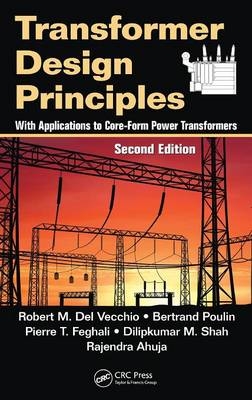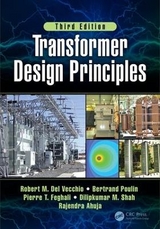
Transformer Design Principles
Crc Press Inc (Verlag)
978-1-4398-0582-4 (ISBN)
- Titel erscheint in neuer Auflage
- Artikel merken
Simplifies presentation and emphasizes fundamentals, making it easy to apply presented results to your own designs
The models, formulae, and methods illustrated in this book cover the crucial electrical, mechanical, and thermal aspects that must be satisfied in transformer design. The text also provides detailed mathematical techniques that enable users to implement these models on a computer. The authors take advantage of the increased availability of electromagnetic 2D and 3D finite element programs, using them to make calculations, especially in conjunction with the impedance boundary method for dealing with eddy current losses in high-permeability materials such as tank walls.
Includes new or updated material on:
Multi terminal transformers
Phasors and three-phase connections
Impulse generators and air core reactors
Methodology for voltage breakdown in oil
Zig-zag transformers
Winding capacitances
Impulse voltage distributions
Temperature distributions in the windings and oil
Fault type and fault current analyses
Although the book’s focus is on power transformers, the transformer circuit models presented can be used in electrical circuits, including large power grids. In addition to the standard transformer types, the book explores multi-terminal transformer models, which allow complicated winding interconnections and are often used in phase shifting and rectifying applications. With its versatile coverage of transformers, this book can be used by practicing design and utility engineers, students, and anyone else who requires knowledge of design and operational characteristics.
Robert M. Del Vecchio received the BS degree in physics from the Carnegie Institute of Technology, Pittsburgh, Pennsylvania, the MS degree in electrical engineering, and the Ph.D. degree in physics from the University of Pittsburgh in 1972. He was a Lecturer in physics at Princeton University, New Jersey, from 1972 to 1976, and an Assistant Professor at the University of Pittsburgh from 1976 to 1978. He then joined the Westinghouse R&D Center, Pittsburgh, where he worked on modeling magnetic materials and electrical devices. He joined North American Transformer (now Waukesha Electric Systems) in 1989, where he developed computer models and transformer design tools. He is a member of the IEEE Power and Energy Society and Magnetics Society. He has served on the IEEE Transformers Committee, the IEC, and a Cigre committee. Currently, he is a consultant. Bertrand Poulin received his Bachelor of Engineering degree in Electrical Engineering from École Polytechnique Université de Montréal in 1978 and his MS degree in High Voltage Engineering in 1988 from the same University. Bertrand started his carreer in a small repair facility for motors, generators and transformers in Montréal in 1978 as a technical advisor. In 1980, he joined the transformer division of ASEA in Varennes, Canada as a test engineer and later as a design and R&D engineer. In 1992, he joined North American Transformer where he was involved in testing and R&D and finally manager of R&D and testing. In 1999, he went back to ABB in Varennes where he holds currently the position of Technical Manager for the Varennes facility and Senior Principal Engineer for the Power Transformer Division of ABB worldwide. He is a member of IEEE Power and Energy Society, an active member of the Transformers Committee, and a registered Professional Engineer in Québec, Canada. Pierre Feghali, PE, MS received his bachelor’s degree in Electrical Engineering from Cleveland State University in 1985 and his Master's degree in Engineering Management in 1996 from San Jose State University. He has worked in the transformer industry for over 23 years. He started his career in distribution transformer design at Cooper Power Systems in Zanesville, Ohio. In 1989, he joined North American Transformer in Milpitas, CA where he was a Senior Design Engineer. Between 1997 and 2002, he held multiple positions at the plant including: production control manager, quality and test manager, and plant manager. He is currently Vice President of Business Development and Engineering at North American Substation Services, Inc. He is a Professional Engineer in the state of California and an active member of the IEEE and PES. Dilipkumar M. Shah received his BSEE degree from the M.S. University of Baroda (India) in 1964 and his MSEE degree in Power Systems from the Illinois Institute of Technology (Chicago, Illinois) in 1967. Since 1967 until 1977, he worked as a transfomer design engineer at Westinghouse Electric, Delta Star, and Aydin Energy Systems. He joined North American Transformer in 1977 as a senior design engineer and then the engineering manager. He left in 2002 and has been working as a transformer consultant for utilities world wide, covering areas such as design reviews, diagnosing transformer failures, and advising transformer manufacturers on improving their designs and manufacturing practices. Rajendra Ahuja graduated from the Univ. of Indore in India where he received a B.Engg. Hons. (Electrical) degree in 1975. He worked at B.H.E.L. and GEC Alsthom India and was involved in design and development of EHV transformers and in the development of wound-in-shield type windings. He also has experience in the design of special transformers for traction, furnace, phase shifting, and rectifier applications. He joined North American Transformer (now Waukesha Electric Systems) in 1994 as a principal design engineer and became the manager of the testing and development departments. He is currently the vice president of engineering. He is an active member of the Power and Energy Society, the IEEE Transformers Committee, and the IEC.
Introduction
Historical Background
Uses in Power Systems
Core-Form and Shell-Form Transformers
Stacked and Wound Core Construction
Transformer Cooling
Winding Types
Insulation Structures
Structural Elements
Modern Trends
Magnetism and Related Core Issues
Basic Magnetism
Hysteresis
Magnetic Circuits
Inrush Current
Distinguishing Inrush from Fault Current
Optimal Core Stacking
Circuit Model of a Two-Winding Transformer with Core
Circuit Model of the Core
Two-Winding Transformer Circuit Model with Core
Approximate Two-Winding Transformer Circuit Model without Core
Vector Diagram of a Loaded Transformer with Core
Per-Unit System
Voltage Regulation
Reactance and Leakage Reactance Calculations
General Method for Determining Inductances and Mutual Inductances
Two-Winding Leakage Reactance Formula
Ideal Two-, Three-, and Multiwinding Transformers
Leakage Reactance for Two-Winding Transformers Based on Circuit Parameters
Leakage Reactances for Three-Winding Transformers
Phasors, Three-Phase Connections, and Symmetrical Components
Phasors
Wye and Delta Three-Phase Connections
Zig-Zag Connection
Scott Connection
Symmetrical Components
Fault Current Analysis
Fault Current Analysis on Three-Phase Systems
Fault Currents for Transformers with Two Terminals per Phase
Fault Currents for Transformers with Three Terminals per Phase
Asymmetry Factor
Phase-Shifting and Zig-Zag Transformers
Basic Principles
Squashed Delta Phase-Shifting Transformer
Standard Delta Phase-Shifting Transformer
Two-Core Phase-Shifting Transformer
Regulation Effects
Fault Current Analysis
Zig-Zag Transformer
Multi-terminal Three-Phase Transformer Model
Theory
Transformers with Winding Connections within a Phase
Multiphase Transformers
Generalizing the Model
Regulation and Terminal Impedances
Multiterminal Transformer Model for Balanced and Unbalanced Load Conditions
Rabins’ Method for Calculating Leakage Fields, Leakage Inductances, and Forces in Transformers
Theory
Rabins’ Formula for Leakage Reactance
Application of Rabins’ Method to Calculate the Self-Inductance of and Mutual Inductance between Coil Sections
Determining the B-Field
Determination of Winding Forces
Numerical Considerations
Mechanical Design
Force Calculations
Stress Analysis
Radial Buckling Strength
Stress Distribution in a Composite Wire-Paper Winding Section
Additional Mechanical Considerations
Electric Field Calculations
Simple Geometries
Electric Field Calculations Using Conformal Mapping
Finite Element Electric Field Calculations
Capacitance Calculations
Distributive Capacitance along a Winding or Disk
Stein’s Disk Capacitance Formula
General Disk Capacitance Formula
Coil Grounded at One End with Grounded Cylinders on Either Side
Static Ring on One Side of Disk
Terminal Disk without a Static Ring
Capacitance Matrix
Two Static Rings
Static Ring Between the First Two Disks
Winding Disk Capacitances with Wound-in Shields
Multistart Winding Capacitance
Voltage Breakdown and High-Voltage Design
Principles of Voltage Breakdown
Geometric Dependence of Transformer-Oil Breakdown
Insulation Coordination
Continuum Model of Winding Used to Obtain the Impulse-Voltage Distribution
Lumped-Parameter Model for Transient Voltage
Distribution
Losses
No-Load or Core Losses
Load Losses
Tank and Shield Losses Due to Nearby Busbars
Tank Losses Associated with the Bushings
Thermal Design
Thermal Model of a Disk Coil with Directed Oil Flow
Thermal Model for Coils without Directed Oil Flow
Radiator Thermal Model
Tank Cooling
Oil Mixing in the Tank
Time Dependence
Pumped Flow
Comparison with Test Results
Determining m and n Exponents
Loss of Life Calculation
Cable and Lead Temperature Calculation
Tank Wall Temperature Calculation
Tieplate Temperature
Core Steel Temperature Calculation
Load Tap Changers
General Description of Load Tap Changer
Types of Regulation
Principles of Operation
Connection Schemes
General Maintenance
Miscellaneous Topics
Setting the Impulse Test Generator to Achieve Close to Ideal Waveshapes
Impulse or Lightning Strike on a Transformer through a Length of Cable
Air Core Inductance
Electrical Contacts
References
Index
| Erscheint lt. Verlag | 3.6.2010 |
|---|---|
| Zusatzinfo | 16 page color insert; 1450-1550 equations; 36 Tables, black and white; 34 Illustrations, color; 285 Illustrations, black and white |
| Verlagsort | Bosa Roca |
| Sprache | englisch |
| Maße | 156 x 234 mm |
| Gewicht | 1018 g |
| Themenwelt | Technik ► Elektrotechnik / Energietechnik |
| ISBN-10 | 1-4398-0582-2 / 1439805822 |
| ISBN-13 | 978-1-4398-0582-4 / 9781439805824 |
| Zustand | Neuware |
| Haben Sie eine Frage zum Produkt? |
aus dem Bereich



